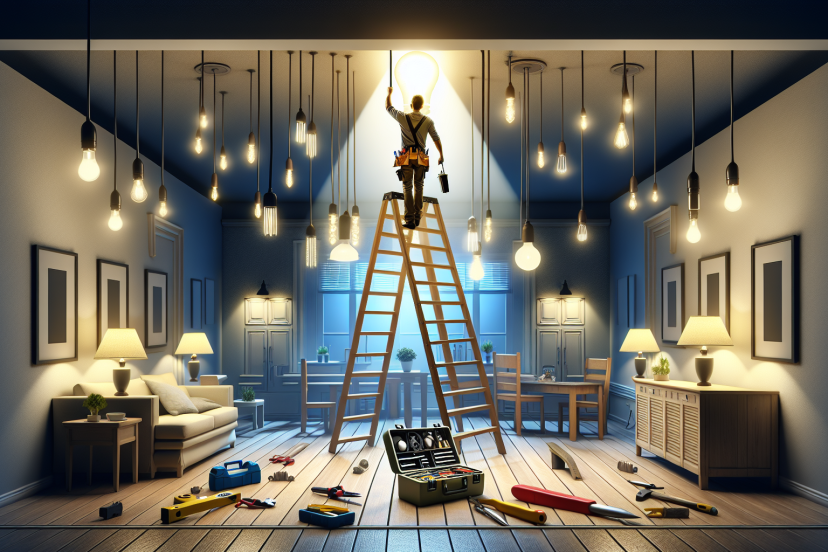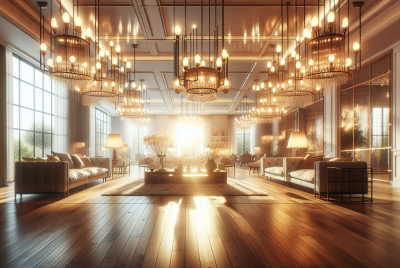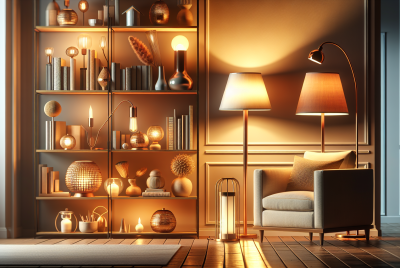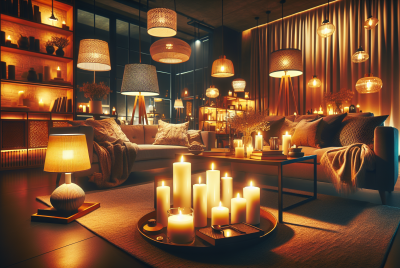Common Mistakes To Avoid When Installing Interior Lighting
Having the right interior lighting can greatly enhance the ambiance and functionality of your space. However, it’s important to avoid some common mistakes when installing interior lighting. From choosing the wrong type of fixtures to inadequate positioning, these errors can greatly affect the overall outcome of your lighting design. By being aware of these common mistakes, you can ensure a successful lighting installation that not only illuminates your space but also creates a welcoming and comfortable atmosphere.
Using the Wrong Type of Lighting
Using mismatched lighting fixtures
One common mistake people make when installing interior lighting is using mismatched lighting fixtures. This can create an inconsistent and disjointed look in your home. It’s important to choose lighting fixtures that complement each other and fit well with the overall style and design of your space. For example, if you have a modern and minimalist living room, using a traditional chandelier as the main light source would look out of place. Make sure to consider the aesthetic vibe you want to achieve and select lighting fixtures accordingly.
Using incompatible bulb types
Another mistake to avoid is using incompatible bulb types. Different bulb types produce different levels of brightness and color temperatures. By using bulbs that are mismatched, you may end up with areas of your home that are too bright or too dim, casting unwanted shadows or creating a harsh and uncomfortable environment. When selecting bulbs, make sure to check their compatibility with the fixture and choose ones that will provide the right amount of light for the intended purpose of the space.
Using incorrect wattage
Using the incorrect wattage for your lighting fixtures can lead to various issues, including excessive energy consumption, overheating, and potentially damaging the bulbs or even causing a fire hazard. It’s important to carefully read the specifications from the manufacturer and adhere to the recommended wattage for each fixture. By following these guidelines, you can ensure that your lighting fixtures function properly and safely.
Neglecting to Plan the Layout
Not considering the purpose of each room
When it comes to interior lighting, it’s crucial to consider the purpose of each room. Different activities and functions require varying levels and types of lighting. For example, a kitchen may require bright and task-oriented lighting to assist with food preparation, while a bedroom may benefit from softer, mood-setting lighting for relaxation. By not taking into account the purpose of each room, you may end up with lighting that doesn’t adequately support the intended activities and atmosphere.
Not taking into account natural lighting
Neglecting to consider the amount of natural lighting in a space can have a significant impact on the effectiveness and efficiency of your lighting design. Natural light can enhance the ambiance of a room and reduce the need for artificial lighting during the day. It’s important to assess the amount and direction of natural light entering a space and strategically plan the placement of your fixtures accordingly. This will help you make the most of natural daylight and minimize energy consumption.
Not planning for task lighting
Task lighting is essential for performing specific activities such as reading, cooking, or working at a desk. However, many homeowners overlook the importance of incorporating task lighting into their lighting plan. By not including dedicated task lighting fixtures or outlets in areas where they are needed, you may strain your eyes or create shadows that hinder your productivity. It’s important to identify the tasks that require additional lighting and choose fixtures or lamps that provide focused and adjustable illumination.
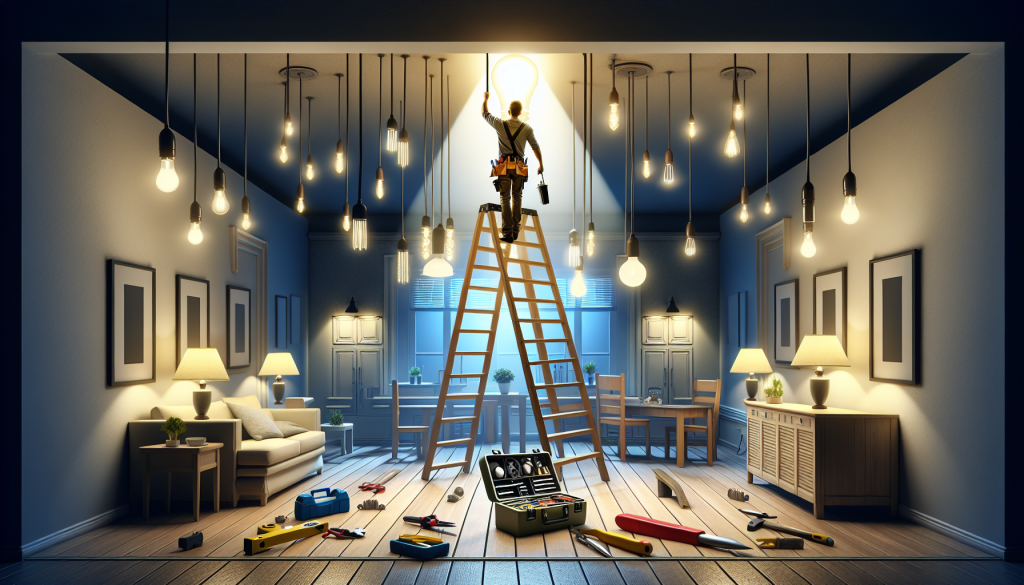
Choosing Inadequate Lighting Levels
Using insufficient lighting for the size of the room
Using insufficient lighting for the size of a room can leave the space feeling gloomy and poorly lit. It’s important to consider the square footage of each room and select lighting fixtures that can adequately illuminate the entire area. A good rule of thumb is to aim for a minimum of 20 lumens per square foot for general lighting. By choosing lighting fixtures that provide adequate brightness, you can create a well-lit and inviting atmosphere in your home.
Using only one light source in a room
Overlooking the need for multiple light sources in a room is a common mistake that can result in uneven lighting and the creation of harsh shadows. Instead of relying solely on one central light fixture, it’s important to incorporate multiple light sources. This can include a combination of overhead lighting, floor or table lamps, and task lighting. By incorporating different light sources, you can create layers of light, add depth to your space, and have flexibility in adjusting the lighting levels to suit various activities and moods.
Overlooking the need for dimmable lighting
The ability to adjust the brightness of your lighting can greatly enhance the ambiance and functionality of a room. Unfortunately, many homeowners overlook the need for dimmable lighting. Dimmers allow you to easily control the intensity of your lighting to create the desired mood or accommodate different activities. Whether you want a bright and lively atmosphere for gatherings or a cozy and relaxing ambiance for movie nights, dimmable lighting provides the flexibility to easily adjust the brightness according to your preferences.
Failing to Consider Color Temperature
Using lights with mismatched color temperatures in the same space
Mismatched color temperatures in the same space can create an unbalanced and unnatural lighting scheme. Color temperature refers to the warmth or coolness of light and is measured in Kelvin (K). Mixing bulbs with different color temperatures can result in different light qualities clashing and producing an undesirable effect. To achieve a cohesive and harmonious lighting design, it’s important to select bulbs with similar color temperatures for each room or area. This will ensure that the lighting appears consistent and pleasing to the eye.
Using cool white lights in warm-toned rooms
The color temperature of lighting can greatly impact the overall mood and atmosphere of a room. Using cool white lights in warm-toned rooms can create a jarring contrast and disrupt the intended aesthetic. Warm-toned rooms, such as those with earthy or cozy color schemes, are best complemented by bulbs that emit a warmer light, such as those with a color temperature of around 2700K to 3000K. This will enhance the warmth and coziness of the space, creating a more inviting and harmonious environment.
Not considering the desired ambiance of the room
Each room in your home serves a different purpose and may require a specific ambiance. Failing to consider the desired ambiance of a room can result in lighting that doesn’t align with the intended mood or atmosphere. For example, a dining room may benefit from a soft and intimate lighting design to create a cozy and comfortable setting for meals, while a home office may require bright and energizing lighting to promote focus and productivity. Take the time to consider the ambiance you want to achieve in each room and select lighting fixtures and bulbs accordingly.
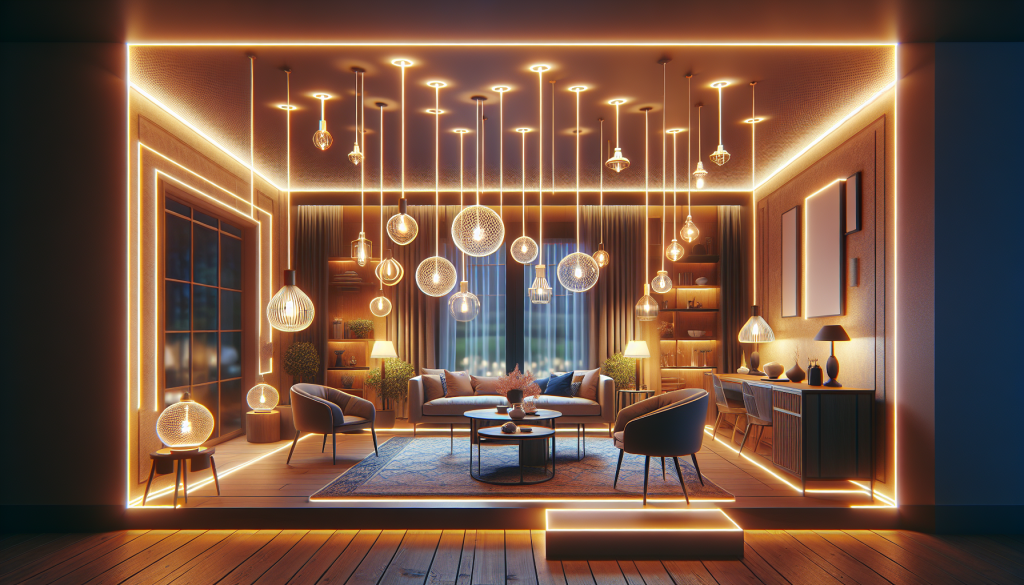
Ignoring Energy Efficiency
Not using energy-efficient bulbs
Ignoring energy efficiency when selecting bulbs can result in higher energy bills and a negative impact on the environment. It’s important to choose energy-efficient bulbs, such as LED or CFL bulbs, which consume significantly less energy compared to traditional incandescent bulbs. While energy-efficient bulbs may have a higher upfront cost, they have a longer lifespan and can save you money in the long run. Additionally, using energy-efficient bulbs reduces greenhouse gas emissions and contributes to a sustainable and eco-friendly home.
Choosing fixtures that waste energy
The choice of lighting fixtures can also impact energy efficiency. Opting for fixtures that waste energy, such as those with poorly designed reflectors or excessive decorative elements that obstruct light output, can result in unnecessary energy consumption. When selecting fixtures, look for designs that are efficient in directing and distributing light effectively. This will maximize the lighting output and minimize energy waste, ultimately reducing your environmental footprint and lowering your energy costs.
Not utilizing natural lighting
Many homeowners overlook the potential of natural lighting as a means of reducing energy consumption. By not utilizing natural lighting, you may rely solely on artificial lighting during the day, leading to unnecessary energy usage. To make the most of natural light, consider the placement of windows, skylights, or light tubes to allow ample daylight to enter your space. Additionally, incorporate window treatments that allow for the control of natural light, such as blinds or curtains. Harnessing natural light can significantly reduce your reliance on artificial lighting, benefiting both the environment and your energy bills.
Improper Placement of Lighting Fixtures
Placing fixtures too high or too low
Improper placement of lighting fixtures can result in ineffective lighting distribution and can even impact the aesthetics of a room. Placing fixtures too high can cast harsh shadows and create an unbalanced lighting scheme, while fixtures placed too low may cause glare or obstruct views. It’s important to consider the height and purpose of a room when determining the placement of fixtures. As a general guideline, chandeliers or pendant lights should typically hang around 30-36 inches above a table or countertop, while ceiling-mounted fixtures should be centered and aligned with the overall height of the room.
Not considering the angle of lighting
The angle at which lighting is directed can greatly impact the effectiveness and ambiance of a space. Not considering the angle of lighting can result in areas of the room being over or underlit. To ensure even lighting distribution, it’s important to aim fixtures in a way that provides adequate illumination without creating unwanted glare or shadows. Adjustable fixtures such as track lighting or wall sconces can be particularly useful in allowing you to adjust and direct the lighting angle according to your needs.
Neglecting to space out fixtures properly
Neglecting to space out lighting fixtures properly can result in an uneven and cluttered appearance. It’s important to consider the size and layout of the room when determining the spacing between fixtures. As a general rule, aim for a uniform distribution of light by spacing fixtures approximately twice the distance from the walls or other fixtures. By spacing out fixtures properly, you can achieve a balanced and visually appealing lighting arrangement that enhances the overall aesthetic of your home.
Using Only Overhead Lighting
Not incorporating other types of lighting
Overreliance on overhead lighting is a mistake that can create a flat and uninspiring lighting design. Incorporating other types of lighting, such as task lighting and accent lighting, is essential to create layers of light and add depth to a space. Task lighting focuses on providing targeted illumination for specific activities, while accent lighting highlights architectural features or decor elements. By incorporating multiple types of lighting, you can create a more dynamic and visually interesting environment.
Not creating layers of light
Creating layers of light involves combining ambient, task, and accent lighting to achieve a well-balanced and functional lighting scheme. Ambient lighting provides overall illumination, while task lighting focuses on specific areas or activities, and accent lighting adds visual interest and highlights focal points. By only relying on overhead lighting, you may miss out on the opportunity to create different lighting levels and moods within a room. To create layers of light, consider incorporating table lamps, floor lamps, or wall sconces to supplement your overhead lighting.
Over-reliance on overhead lighting
Over-relying on overhead lighting can result in a lack of flexibility and control over the lighting in a room. Different tasks and activities require varying levels of brightness, and relying solely on one central light source may not adequately meet those needs. Adding additional lighting sources, such as lamps or under-cabinet lighting, allows you to adjust the lighting to the specific requirements of each space. By incorporating various lighting sources, you can achieve a more versatile and adaptable lighting design.
Forgetting About Lighting Controls
Not installing dimmer switches
Dimmer switches provide the ability to adjust the brightness of your lighting fixtures, allowing you to create different moods and atmospheres within a room. Not installing dimmer switches is a missed opportunity for customization and control. Whether you want bright lighting for tasks or a soft and relaxing ambiance for winding down, dimmers provide the flexibility to easily adjust the lighting to your preference. Consider installing dimmer switches for your main light sources to enhance the versatility and functionality of your lighting design.
Not considering automation options
Automation options for lighting provide convenience and energy efficiency. Neglecting to consider automation options means missing out on the ability to program lighting schedules, control lighting remotely, or even integrate lighting into a smart home system. Automation can enhance your daily routines by automatically adjusting lighting levels based on the time of day or occupancy, saving energy and simplifying your life. Explore the various automation options available, such as motion sensors or smart home hubs, to optimize your lighting control.
Neglecting to include separate controls for different areas
Each area or zone in your home may have different lighting needs and preferences. Neglecting to include separate controls for different areas can lead to frustration and limited functionality. For example, a living room with multiple seating areas may benefit from separate controls that allow each area to have its own lighting settings. This allows for customization and flexibility to meet the specific requirements of each space. Consider incorporating separate controls or switches to provide individualized lighting control for different areas or zones in your home.
Ignoring Safety Measures
Not using proper electrical wiring
Ensuring proper electrical wiring is crucial to maintain the safety and functionality of your lighting fixtures. Neglecting to use proper electrical wiring or attempting to install lighting fixtures without professional guidance can pose serious risks. It’s important to follow electrical codes and regulations in your area and consult a licensed electrician if you are unsure or uncomfortable with wiring installations. By prioritizing safety and using proper electrical wiring techniques, you can avoid potential hazards and safeguard your home.
Not following weight restrictions for fixtures
Each lighting fixture comes with weight restrictions that indicate the maximum load it can safely support. Ignoring these weight restrictions can result in fixtures falling and causing damage or injury. When installing lighting fixtures, make sure to verify the weight of the fixture and ensure that the mounting structure and location can safely support it. If you have any doubts or concerns, consult professionals to properly assess the structural integrity and feasibility of installing heavier fixtures.
Using flammable materials near lighting fixtures
Placing flammable materials near lighting fixtures is a safety hazard that should be avoided. Materials such as paper, fabric, or highly flammable objects should not be in direct contact with light bulbs or fixtures that emit heat. The heat generated by lighting fixtures can potentially ignite flammable materials, leading to a fire. Take precautions to keep flammable materials away from lighting fixtures and ensure that fixtures are properly ventilated and installed according to safety guidelines.
Not Considering Maintenance
Choosing fixtures that are difficult to clean
Maintenance is an integral part of keeping your interior lighting fixtures in good condition and maximizing their lifespan. However, many homeowners overlook the importance of choosing fixtures that are easy to clean. Fixtures with intricate or hard-to-reach components can be time-consuming and challenging to maintain. When selecting fixtures, prioritize those with accessible and removable parts that can be easily cleaned and maintained, thus ensuring the longevity and optimal performance of your lighting fixtures.
Not considering the lifespan of bulbs
The lifespan of bulbs varies depending on the type and quality. Choosing bulbs without considering their lifespan can lead to more frequent replacements and added costs. LED bulbs, for example, have a significantly longer lifespan compared to traditional incandescent bulbs. By selecting bulbs with longer lifespans, you can reduce the frequency of bulb replacements, thus saving time and money in the long run. It’s important to research and choose bulbs with reliable manufacturers that offer bulbs with extended lifespans.
Not having a maintenance plan in place
Not having a maintenance plan in place can lead to inconsistent upkeep of your interior lighting. It’s important to establish a regular maintenance routine to ensure the longevity and optimal performance of your fixtures. This can include tasks such as dusting and cleaning fixtures, replacing bulbs when necessary, and inspecting wiring and connections for any signs of damage or wear. By having a maintenance plan and sticking to it, you can prolong the lifespan of your lighting fixtures and ensure a well-lit and safe home environment.

